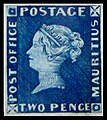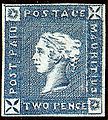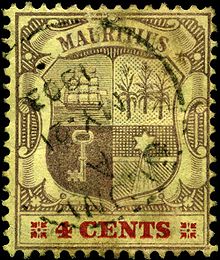Postal history and postage stamps of Mauritius
The postal history of Mauritius goes back to the 17th century and is also known to non- philatelists thanks to the stamps issued by the Red and Blue Mauritius .
Beginnings of the postal system
The originally uninhabited island of Mauritius was an important supply station for water and fresh food on the sea route from Europe to India. As early as the early 17th century, crew members of ships calling left messages in bottles and jugs, which they hung on exposed trees near convenient anchorages.
During the period of French colonial rule, the first official postal service was set up in the capital Port Louis on what was then known as Île de France . The service included the distribution of mail and a local newspaper by messengers as well as the acceptance of letters overseas which were forwarded to departing ships. In 1811 the island became a British colony and the postal service was expanded. Above all, the regular connections to Europe, India and the Cape Colony , as well as a postal route between Port Louis and Mahébourg , were a significant improvement.
Postal reform and first postage stamps
In 1842 Sir William Maynard Gomm became governor of the island. At that point, the postal service was in poor shape. There was no longer a delivery service and letters from incoming ships were only held ready for collection at the post office. The post accepted letters for ship transportation, but was so unreliable that the residents mostly bypassed the postal monopoly and personally handed their mail over to the ship's captains. Gomm had learned about Rowland Hill's postal reforms in the UK and was now starting to reform the colony's postal system along a similar pattern. In December 1846 Ordinance No. 13, which reorganized the postal service and provided for the issue of postage stamps . The tariffs for first-weight letters were set at 1 pence for mail within Mauritius and 2 pence for mail to Rodrigues and other parts of the British Empire, including the mainland. In 1847 James S. Brownrigg was appointed postmaster general and entrusted with the establishment of a postal network on the island and the preparation of the first stamp issue. Brownrigg opened post offices in Mahébourg, Flacq , Pamplemousses , Souillac , Black River , Curepipe , Grand Baie , Moka , Plaines Wilhems , Poudre d'Or and Village Bague within a short period of time , which also ensured that the rural areas could be supplied with mail. The mail connection overseas was maintained by ships on the P&O line.
Joseph Osmond Barnard (1816–1865), a miniature painter and engraver, was commissioned to engrave the printing plate for the first postage stamps . He was to create postage stamps based on the British model with the portrait of Queen Victoria in the denominations of 1 penny and 2 pence, which should also show the name of the colony in order to be able to distinguish it from postage stamps of the motherland. Barnard made a single printing plate, which was the back of a small copper plate already used to print a business card . Since both stamps were engraved next to each other and should have different colors, each stamp had to be printed individually. The circulation was 500 pieces for each value. These stamps went on sale on September 21, 1847 and were sold out within a few weeks. The two stamps did not become known to collectors until 1864 and since no information on the history of their origin was available at that time, they were considered to be misprints, because instead of being postpaid , as on the left margin of the second issue for 1 penny and 2 pence, the Wore inscription Post Office . This assumption has been disproved since the original printing plate was found again in 1912 and other documents on the history of its origin.
Barnard had already engraved the printing plates for the second edition on May 2, 1848. The values, the motif and the design were almost unchanged, with the exception of the lettering Post Paid (" Post Paid " instead of "Post Office") on the left and the number of Marks per print sheet (12 marks per print sheet in one value each instead of 2 marks per print sheet in two different values). To ensure more efficient production, separate plates with 4 lines of 3 stamps each were engraved for the red 1 penny and the blue 2 pence. These two values were printed in at least five editions with a total of 50,000 copies per value and remained in use until 1859. At the end of the process, the printing plates were so worn that the design was only vaguely visible.
In 1859 the Postmaster General commissioned the engraver Robert Sherwin to re-engrave the printing plates. Only the 2 pence plate was completed and used to print a new edition, the 1 pence plate was no longer used.
Brands with the Britannia motif
As early as 1848, the Postmaster General had ordered stamps from the Crown Agents in London , who commissioned the Perkins, Bacon & Petch printing company with the production. The first delivery of the new stamps took place in 1849. The design shows a harbor scene with Britannia seated, armed with a lance and shield, in front of a pile of goods. This motif, which was supposed to symbolize trade and defense, had no indication of value. The value grade could only be determined by the color, which reduced production costs, since only one printing form was required for all value grades. The same motif was introduced in Trinidad and Barbados with the corresponding names of the colonies . For reasons that are no longer known, this system of color coding was not accepted by the Postmaster General and the printed sheets initially disappeared in the archive. In 1858 10,000 copies of the green Britannia were overprinted with the word FOUR PENCE , as this value class was required for letters sent overseas. In the same year, a new shipment of stamps in the denominations of 6 pence and 1 shilling came to Mauritius. These stamps had a value, but in sans serif , which did not harmonize with the MAURITIUS lettering in serif font . The third delivery took place in 1860, this time the colors had been changed. The fourth and final shipment of 1861 contained the first perforated stamps for Mauritius.
Latest local editions
Between 1849 and 1859, the 1 penny and 2 pence post-paid stamps of the second issue remained in use despite the Britannia stamps supplied. Only a red-violet Britannia with no indication of value was used as a 1 penny stamp because the old printing plate of the second edition was too worn out. In 1859 the Postmaster General placed an order to re-engrave the 2 pence printing plate from Jules Lapirot, an actor of French descent, after the plate re-engraved by Sherwin was worn out again. After five months, Lapirot delivered the printing plate with a new engraving. The now very coarse engraving no longer showed any resemblance to Queen Victoria's portrait; collectors call this brand a dog head or monkey head . Despite the apparent poor execution, marks were printed and used from the plate.
In the same year (1859) another Frenchman, Louis Adolphe Dardenne, was commissioned to design new printing plates for 1 and 2 pence. Dardenne created a printing plate of 72 stamps for each value. The upper text bar bears the name of the colony, the value of the brand appears below. The edge strips are taken up by a meander band and thus resemble contemporary French Ceres postage stamps . The stamps were printed using the lithography process with an edition of 70,000 copies each.
The Victoria editions of De La Rue
From 1860 the British printer De La Rue took over the production of postage stamps for Mauritius. A uniform design with a profile representation of the queen in a medallion was produced using the letterpress process. From 1863 the stamps appeared on watermarked paper . This portrait of the queen remained in use until 1895, albeit with different frames. Since the currency was changed from pound sterling to Mauritius rupee in 1878 , large remaining stamps had to be overprinted with new currency information. The postal area of Mauritius at this time also included the Seychelles , Rodrigues and the Chagos Archipelago .
During this period, the construction of a railway network in Mauritius also fell, the first railway line was opened in 1864. Each station received a post office and the trains were equipped with rail mail cars . This service lasted until 1956.
Reorganization of the postal area and development up to independence
In 1890 the postal area of the Seychelles was separated from Mauritius, although the archipelago was formally part of Mauritius until 1903.
From 1895 a new series of postage stamps with the coat of arms of the colony was introduced. These brands were also used for fiscal purposes, as indicated by the Postage & Revenue label . This made very high levels of value necessary, which required special security features. In order to make it more difficult to remove the cancellation stamps, an easily soluble special color was used, which was only available in shades of purple and green. The stamps were printed in these colors on colored paper. As a further security measure, the De La Rue printing company first used coated paper in 1904 .
In order to reduce the costs of the postage stamp production of the huge British colonial empire, De La Rue used so-called keyplates from 1879 , which contained free fields for the name of the colony and the value. This information could then be printed in a second step, usually in other colors. From 1910 these plates were first used for Mauritius. The keyplate system was used for postage stamps until 1938, with the printing plates being renewed when the sovereign changed.
In the 1930s, the issuing program for special postage stamps was standardized by introducing so-called omnibus issues, i.e. H. Issued stamps with the same motifs on the same occasion throughout the British Empire. This practice was maintained until independence from Mauritius.
On November 10, 1933, the first airmail from Réunion arrived in Mauritius. The first direct airmail connection to Europe was established in 1937.
Independent state
The independence of Mauritius in 1968 had an impact on the postal service of the archipelagos, which were still under British administration. As early as 1965, the colonial administration had split off the islands of Aldabra , Farquhar and Desroches from the Crown Colony of Seychelles and united them with the Chagos Archipelago, which previously belonged to the Mauritius postal area, to form the British Indian Ocean Territory , which became an independent postal area from January 1968.
Until March 1992 Mauritius was a monarchy in the Commonwealth of Nations with Elizabeth II as monarch. Many postage stamps from this period feature a small portrait of the Queen in the upper right or left corner. After the change of the form of government to a republic , a small national coat of arms was printed in its place, but this practice was abandoned after 2000.
4c stamp from a keyplate with the portrait of George V (1932)
25c stamp from the 1938 series with the portrait of George VI.
literature
- Christian le Comte: The Stamps of Mauritius . le Comte Publishers, Port Louis 2006, 80 pages, ISBN 0-9550285-3-1
- Hiroyuki Kanai: Classic Mauritius. The Locally Printed Postage Stamps 1847-59. Publisher: Stanley Gibbons, London 1981, 132 pages, ISBN 0-85259-251-5
- Peter Ibbotson: Mauritius Postal History and Stamps , The Royal Philatelic Society London, 1991, 239 pages, ISBN 0-900631-24-4
- Peter Ibbotson: Mauritius Postal History and Stamps: Revisions and Additions , Indian Ocean Study Circle, Newbury (Berkshire) 1995, 117 pages, ISBN 0-9526407-0-8
- Bob Lamb: Mauritius. In: American Philatelist July 2012 issue; from the series of articles / category Worldwide In A Nutshell
Web links
- History of the Post in Mauritius , accessed August 3, 2010
- Illustration of all post offices and stamps . Archived from the original on December 8, 2013.













